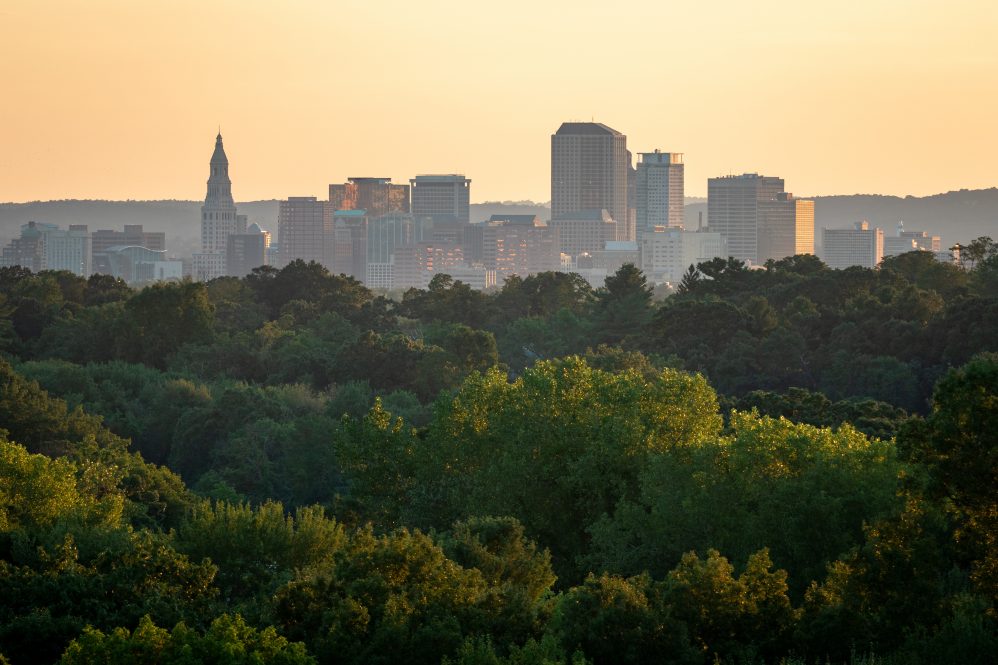With increasing rates of extinction and biodiversity loss across the globe, scientists are debating whether we are living during the earth’s sixth mass extinction event, prompting a drive to accelerate our conservation efforts, with researchers working to understand how to protect as many species and ecosystems as possible.
In their recent paper in Biological Conservation, UConn Department of Ecology and Evolutionary Biology researcher and post-doc Steven Presley and Board of Trustees Distinguished Professor and Executive Director of the Institute of the Environment Michael Willig and their colleagues looked at three strategies for creating conservation networks and assessed the effectiveness of each.
Human activities like agriculture, urban development, or deforestation are forms of habitat conversion that result in habitat loss and fragmentation. The resulting pockets of land act like isolated islands of habitat, which increase a species’ risk of becoming locally extinct. Connecting those habitat islands by corridors is a way to reduce that risk, because it makes it easier for new members of the same species to emigrate to isolated habitat patches and “rescue” that population.
“Constructing networks as a strategy for minimizing the negative impacts of habitat loss and fragmentation is a great idea,” says Willig, “but: what is the best strategy for constructing such a network, and what are the consequences from a variety of perspectives?”
Willig explains that historically, most conservation work has focused on species richness, which considers all species to be equally different. The researchers wanted to see the consequences of nature preserves constructed based on species richness versus other aspects of biodiversity, like phylogenetic diversity or functional diversity, which may have closer linkages to ecosystem services and the species’ long-term resilience.
“There are a lot of reasons that most conservation work has focused on species richness,” says Willig, “One reason is it’s a relatively easy metric to measure, but that doesn’t mean we have sufficient data on the complete inventories of species,” a necessary characteristic for constructing conservation networks.
Biodiversity is more than just species richness, explains Presley. Each species has its own variety of activities that it performs within an ecosystem; these activities contribute to functional diversity. Phylogenetic diversity reflects the evolutionary history represented in a group of species. It represents evolutionary potential to adapt to circumstances in the future.
“Functional diversity is highly correlated with phylogenetic diversity, so the more distant two species are in an evolutionary tree, often the more dissimilar they are in terms of their function as well. Two species in the same genus probably do the same things,” says Willig. “We have pretty good phylogenetic information on a lot of taxa, but we have pretty poor information about the functions of species so phylogenic information may be a good surrogate for functional information.”
Though limited by the availability of data, the researchers analyzed data from conservation efforts from three different scenarios, each in a very different site, including data for birds in Connecticut, bats in Paraguay, and trees in North Carolina.
The way conservation networks are constructed is mostly by default, says Presley, for instance, with land becoming available by happenstance. The researchers wanted to see how impactful this simple, random approach is compared to more research-intensive strategies.
Two other approaches for constructing networks were analyzed. One is called “the simultaneous strategy,” where for a network of every size, all possible combinations of sites are analyzed to see which will maximize species richness to the greatest effect.
The other strategy is a more realistic, “stepwise approach,” says Willig. In the sequential approach, once any sites are contained in a network, the evaluation of additional sites is based on which would be the best complement to those already in the network.
“We wanted to cover the gamut of strategies, and our gut feeling was the simultaneous approach would be much better than the sequential approach, and both would be better than the random approach in terms of conserving species richness. The consequences in terms of the other two dimensions of biodiversity were not obvious,” he says.
After analyzing the data, the researchers found the non-random strategies are better at consistently maximizing species richness, which occurred when approximately five to 10 interconnected sites were included within a conservation network. Richness-based approaches in general are effective methods to use when constructing a conservation network.
“The good thing was that a reasonably small proportion of the total number of sites that were available needed to be included in a network to maximize the richness that you protect. This was true regardless of which strategies you followed, and was true for birds, bats, and trees,” says Willig.
Presley says the results reflect a happy accident, because the most effective methods reflect how conservation networks tend to be constructed naturally:
“Humans have an innate desire to collect things that look different, so if you’re going to construct a network in Connecticut starting from scratch for instance, you want to try to figure out what kind of habitat types we have and then collect at least one of everything.”
This theoretical network would likely have forests, wetlands, grasslands, and some coastal areas – a little bit of everything — and this natural tendency is a rudimentary way of maximizing species richness. This complementarity happens because each site tends to have more unique species in it compared to the other sites than if they were randomly chosen.
“I think a lot of conservation strategies for constructing networks have been successful because they either maximize the number of habitats are represented, or they maximize the number of species. Both of those approaches reinforce each other at getting to a good solution for conservation,” says Willig.
Presley points out that conservation networks are growing in popularity, and they started from a need to span geopolitical boundaries,
“There are growing collaborations and it gets a little hierarchical, so if states do what they need to do, then by default, the country does what it needs to do, then by default, the continent does what it needs to do so to speak,” he says. “There is network development from local to regional to continental and global. It takes a lot of international cooperation, which is always challenging.”
Though challenging, this work is vital. Willig adds there are millions of species in nature, including millions that have yet to be identified, and it is important to know how effective conservation action is and if it is enough for preserving the full complement of biodiversity.
“We know conservation has a variety of strategies for attaining long-term protection of biodiversity and only by incorporating a multitude of tools and approaches can we hope to preserve what is left, especially during a time when we’re losing diversity at accelerating rates,” he says.



